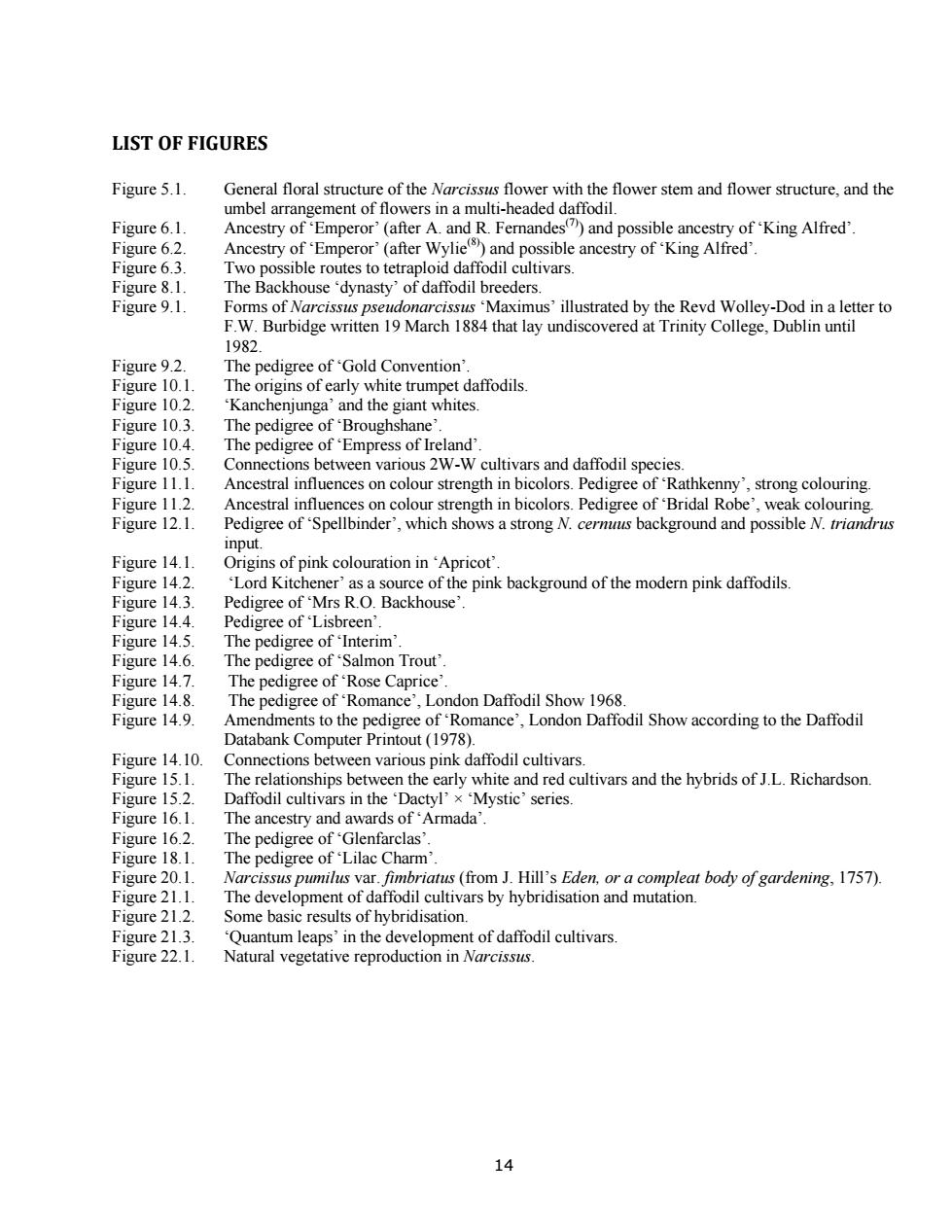
LIST OF FIGURES Figure 5 1 General floral structure of the narcissus flower with the flower stem and flower structure and the umbel arrangement of flowers in a multi-headed daffodil. Figure 6. Ancestry of'Emperor'(after A.and R.Fernandes)and possible ancestry of'King Alfred' Figure 6.2 Ancestry of Emperor (after Wylie)and possible ancestry of King Alfred'. Figure 6. ble routes to tetraplo gure The Ba gure s'illu F.W.Burbidge written 19 March 1884 that lay undi vered at Trinity Cole 19R7 Figure 92 The pedigree of Gold Convention' Figure 10.1. The origins of early white trumpet daffodils Figure 10.2 Kanchenjunga'and the giant whites. The pedigree of Broughshane Figure Empress or A ral ina e11.2 on colour str th in bicolors.Pedis Robe' Pedigree of Spellbinder',which shows a strong N.cermus background and possible N.triandrus input Figure 14.1 Origins of pink colouration in 'Apricot Figure 14.2 "Lord Kitchener'as a source of the pink background of the modern pink daffodils. Figure 14. K.C Backhouse Figure 14 gree of een The n Trout' ure 14.7 The pedigree of 'Rose Caprice Figure 14.8. The pedigree of Romance'.London Daffodil Show 1968. Figure 14.9. Amendments to the pedigree of 'Romance',London Daffodil Show according to the Daffodil Databank Computer Printout (1978) Figure 14.10 Connections between various pink daffodil cultivars eand red cultivars and the hybrids of L .Richardson nd rds of mada re 16 The p of'Glenfarclas re18 The pedigree of 'lilac charm Figure 20.1 Narcissus pumilus var.fimbriatus (from J.Hill's Eden,or a compleat body of gardening,1757) Figure 21.1 The development of daffodil cultivars by hybridisation and mutation. Figure 21. Some basic results of hybric sation Quantum leap in the d celopmentofdafodlcultivas ction in 14
14 LIST OF FIGURES Figure 5.1. General floral structure of the Narcissus flower with the flower stem and flower structure, and the umbel arrangement of flowers in a multi-headed daffodil. Figure 6.1. Ancestry of ‘Emperor’ (after A. and R. Fernandes(7)) and possible ancestry of ‘King Alfred’. Figure 6.2. Ancestry of ‘Emperor’ (after Wylie(8)) and possible ancestry of ‘King Alfred’. Figure 6.3. Two possible routes to tetraploid daffodil cultivars. Figure 8.1. The Backhouse ‘dynasty’ of daffodil breeders. Figure 9.1. Forms of Narcissus pseudonarcissus ‘Maximus’ illustrated by the Revd Wolley-Dod in a letter to F.W. Burbidge written 19 March 1884 that lay undiscovered at Trinity College, Dublin until 1982. Figure 9.2. The pedigree of ‘Gold Convention’. Figure 10.1. The origins of early white trumpet daffodils. Figure 10.2. ‘Kanchenjunga’ and the giant whites. Figure 10.3. The pedigree of ‘Broughshane’. Figure 10.4. The pedigree of ‘Empress of Ireland’. Figure 10.5. Connections between various 2W-W cultivars and daffodil species. Figure 11.1. Ancestral influences on colour strength in bicolors. Pedigree of ‘Rathkenny’, strong colouring. Figure 11.2. Ancestral influences on colour strength in bicolors. Pedigree of ‘Bridal Robe’, weak colouring. Figure 12.1. Pedigree of ‘Spellbinder’, which shows a strong N. cernuus background and possible N. triandrus input. Figure 14.1. Origins of pink colouration in ‘Apricot’. Figure 14.2. ‘Lord Kitchener’ as a source of the pink background of the modern pink daffodils. Figure 14.3. Pedigree of ‘Mrs R.O. Backhouse’. Figure 14.4. Pedigree of ‘Lisbreen’. Figure 14.5. The pedigree of ‘Interim’. Figure 14.6. The pedigree of ‘Salmon Trout’. Figure 14.7. The pedigree of ‘Rose Caprice’. Figure 14.8. The pedigree of ‘Romance’, London Daffodil Show 1968. Figure 14.9. Amendments to the pedigree of ‘Romance’, London Daffodil Show according to the Daffodil Databank Computer Printout (1978). Figure 14.10. Connections between various pink daffodil cultivars. Figure 15.1. The relationships between the early white and red cultivars and the hybrids of J.L. Richardson. Figure 15.2. Daffodil cultivars in the ‘Dactyl’ × ‘Mystic’ series. Figure 16.1. The ancestry and awards of ‘Armada’. Figure 16.2. The pedigree of ‘Glenfarclas’. Figure 18.1. The pedigree of ‘Lilac Charm’. Figure 20.1. Narcissus pumilus var. fimbriatus (from J. Hill’s Eden, or a compleat body of gardening, 1757). Figure 21.1. The development of daffodil cultivars by hybridisation and mutation. Figure 21.2. Some basic results of hybridisation. Figure 21.3. ‘Quantum leaps’ in the development of daffodil cultivars. Figure 22.1. Natural vegetative reproduction in Narcissus
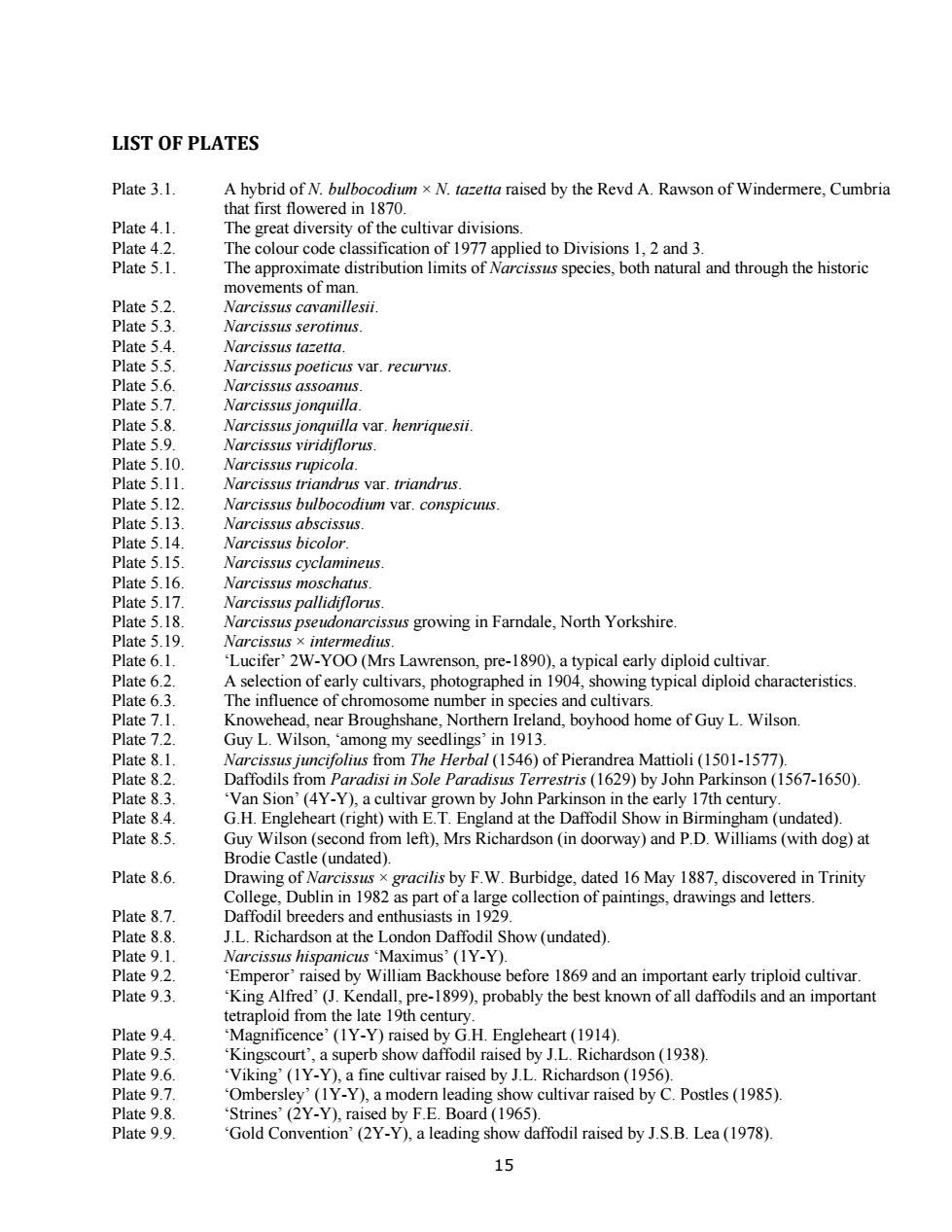
LIST OF PLATES Plate 3 1 A hybrid of N.bulbocodium x N.tazetta raised by the Revd A.Rawson of Windermere.Cumbria that first flowered in 1870. Plate 4. The great dive the cultivar divisions e colour code on 1,2 and3 The appro dis arcissus species,both natural and through the histori Plate 52 Plate 5 3 Narcissus serotinus Plate 5.4 Narcissus tazetta Plate 5. Narcissus poeticus var.recurvus. Narcissus jonqu d var. Plate 5.10 Na Plate 5 11 Narcissus triandrus var.triandrus Plate 5.12. Narcissus bulbocodium var.conspicuus. Plate 5.13 Narcissus abscissus Plate 5.14 Narcissus bicolor Plate Narcissus cyc 51 Plate 5 18 owing in Farndale.North Yorkshire Plate 5.19. Plate 6 1 'Lucifer'2W-YOO(Mrs Lawrenson,pre-1890),a typical early diploid cultivar. Plate 6.2 A selection of early cultivars,photographed in 1904,showing typical diploid characteristics Plate 6. The influence of chromosome number in species and cultivars. Kno land,boyhood home of Guy L.Wilson. ng my 913 )of Pie a Mattioli(1501-1577 T 1567.16501 Plate 3 Van Sion'(4Y-Y)a cul ivar by lohn Parkin n in the ear 17th centur Plate 8 4 G.H.Engleheart (right)with ET.England at the Daffodil Show in Birmingham (undated). Plate 8.5. Guy Wilson(second from left),Mrs Richardson(in doorway)and P.D.Williams(with dog)at Brodie Castle (undated). Plate 8.6. Dra wing o gracilis F.W.B rbidge,dated 16 May 1887,disco part of a Ic Plate 8.7 Ric rd Daffodil Show (undated) Plate 9 1 us "Maximu Plate 9 2 Emperorraised by William Backhouse before 1869 and an important early triploid cultivar. Plate 9 3 'King Alfred'(J.Kendall,pre-1899),probably the best known of all daffodils and an important tetraploid from the late 19th century Plate 9.4. Magnificence'(1Y-Y)raised by G.H.Engleheart(1914) Kingscour ed by J.L. cuvar raised by (2Y-Y rd( Plate9.9. Gold Convention'(2Y-Y).a leading show daffodil raised by J.S.B.Lea(1978) 15
15 LIST OF PLATES Plate 3.1. A hybrid of N. bulbocodium × N. tazetta raised by the Revd A. Rawson of Windermere, Cumbria that first flowered in 1870. Plate 4.1. The great diversity of the cultivar divisions. Plate 4.2. The colour code classification of 1977 applied to Divisions 1, 2 and 3. Plate 5.1. The approximate distribution limits of Narcissus species, both natural and through the historic movements of man. Plate 5.2. Narcissus cavanillesii. Plate 5.3. Narcissus serotinus. Plate 5.4. Narcissus tazetta. Plate 5.5. Narcissus poeticus var. recurvus. Plate 5.6. Narcissus assoanus. Plate 5.7. Narcissus jonquilla. Plate 5.8. Narcissus jonquilla var. henriquesii. Plate 5.9. Narcissus viridiflorus. Plate 5.10. Narcissus rupicola. Plate 5.11. Narcissus triandrus var. triandrus. Plate 5.12. Narcissus bulbocodium var. conspicuus. Plate 5.13. Narcissus abscissus. Plate 5.14. Narcissus bicolor. Plate 5.15. Narcissus cyclamineus. Plate 5.16. Narcissus moschatus. Plate 5.17. Narcissus pallidiflorus. Plate 5.18. Narcissus pseudonarcissus growing in Farndale, North Yorkshire. Plate 5.19. Narcissus × intermedius. Plate 6.1. ‘Lucifer’ 2W-YOO (Mrs Lawrenson, pre-1890), a typical early diploid cultivar. Plate 6.2. A selection of early cultivars, photographed in 1904, showing typical diploid characteristics. Plate 6.3. The influence of chromosome number in species and cultivars. Plate 7.1. Knowehead, near Broughshane, Northern Ireland, boyhood home of Guy L. Wilson. Plate 7.2. Guy L. Wilson, ‘among my seedlings’ in 1913. Plate 8.1. Narcissus juncifolius from The Herbal (1546) of Pierandrea Mattioli (1501-1577). Plate 8.2. Daffodils from Paradisi in Sole Paradisus Terrestris (1629) by John Parkinson (1567-1650). Plate 8.3. ‘Van Sion’ (4Y-Y), a cultivar grown by John Parkinson in the early 17th century. Plate 8.4. G.H. Engleheart (right) with E.T. England at the Daffodil Show in Birmingham (undated). Plate 8.5. Guy Wilson (second from left), Mrs Richardson (in doorway) and P.D. Williams (with dog) at Brodie Castle (undated). Plate 8.6. Drawing of Narcissus × gracilis by F.W. Burbidge, dated 16 May 1887, discovered in Trinity College, Dublin in 1982 as part of a large collection of paintings, drawings and letters. Plate 8.7. Daffodil breeders and enthusiasts in 1929. Plate 8.8. J.L. Richardson at the London Daffodil Show (undated). Plate 9.1. Narcissus hispanicus ‘Maximus’ (1Y-Y). Plate 9.2. ‘Emperor’ raised by William Backhouse before 1869 and an important early triploid cultivar. Plate 9.3. ‘King Alfred’ (J. Kendall, pre-1899), probably the best known of all daffodils and an important tetraploid from the late 19th century. Plate 9.4. ‘Magnificence’ (1Y-Y) raised by G.H. Engleheart (1914). Plate 9.5. ‘Kingscourt’, a superb show daffodil raised by J.L. Richardson (1938). Plate 9.6. ‘Viking’ (1Y-Y), a fine cultivar raised by J.L. Richardson (1956). Plate 9.7. ‘Ombersley’ (1Y-Y), a modern leading show cultivar raised by C. Postles (1985). Plate 9.8. ‘Strines’ (2Y-Y), raised by F.E. Board (1965). Plate 9.9. ‘Gold Convention’ (2Y-Y), a leading show daffodil raised by J.S.B. Lea (1978)
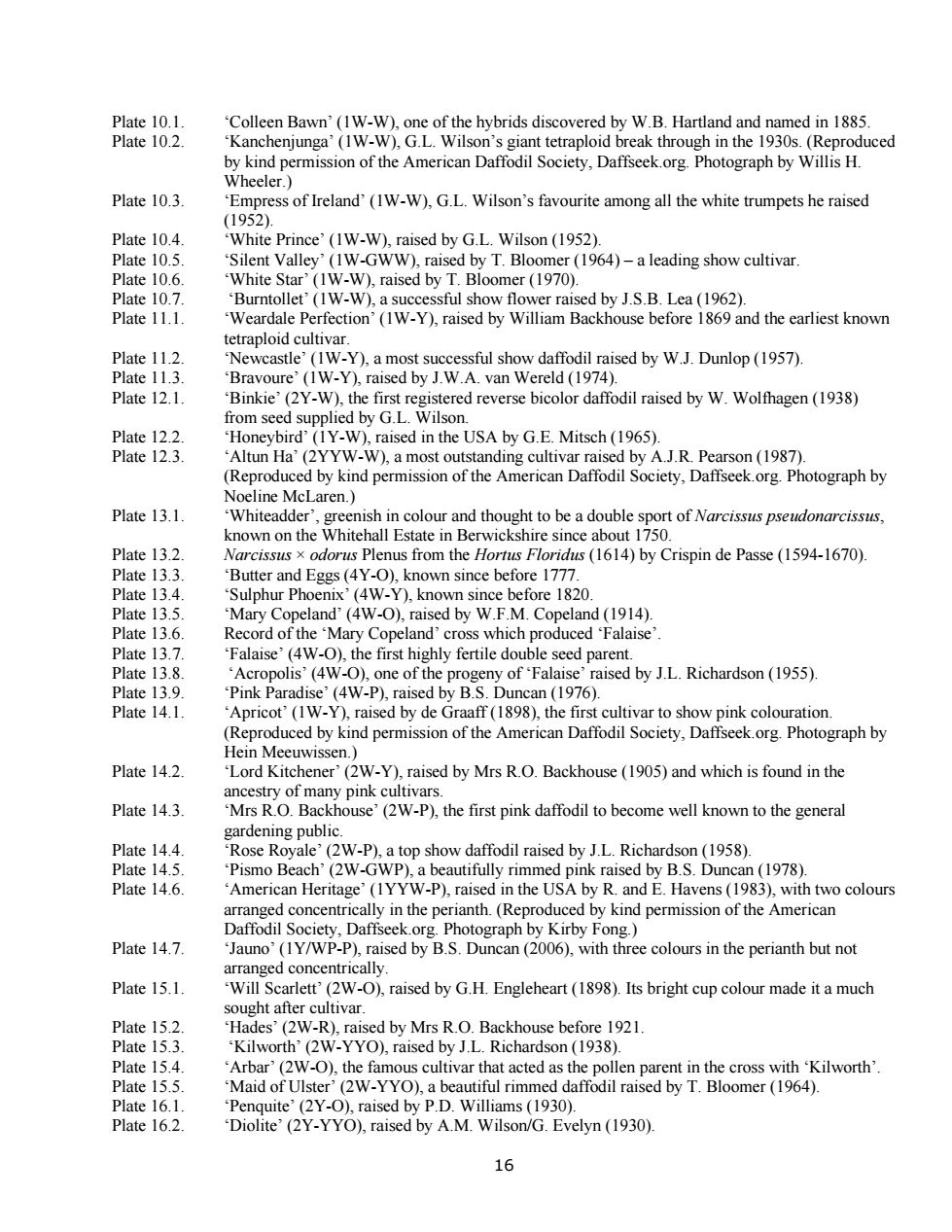
P18 tetraplo through in U duce ck.org Photograph by WillisH Plate 103 ss of Ireland'(1W-W),G.L.Wilson's favourite among all the white trumpets he raised 1952 Plate 10.4. White Prince'(1W-W)raised by GL Wilson (1952) Plate 10.5. 'Silent Valley'(1W-GWW),raised by T.Bloomer(1964)-a leading show cultivar Plate 10.6 White Sta (IW-W),raised by T.Bloomer (1970). W),a suc by J.S.B Lca(1962) tic -Y),raised by William E house before nd the earliest known tetrapl Plate 112 w daffodil raised by wI Dunlon (1957 Plate 11.3. 'Bravoure'(IW-Y).raised by J.W.A.van Wereld (1974). Plate 12.1. 'Binkie'(2Y-W),the first registered reverse bicolor daffodil raised by W.Wolfhagen(1938) from seed supplied by G.L.Wilson. Plate 12.2 Honeybird'(1Y-W),raised in the USA by G.E.Mitsch(1965) Plate 12.3 rson(1987) (Reprod Whit dder aren.) of na on the Whitehall Estate ir us pseudonarcissus R about 1750 Plate 132 Narcissus x odorus Plenus from the Hortus Floridus (1614)by Crispin de Passe(1594-1670). Plate 13.3. 'Butter and Eggs (4Y-O).known since before 1777 Plate 13.4 Sulphur Phoenix (4W-Y),known since before 1820 Plate 13 Mary Copeland 4W-).ra sed by w. M.Co peland (1914) laise (w ghly f B.S D J.L.Richardson(1955 n1076 Plate 14 .Apricot'(W-Y).raised by de Graaff(1898),the first cultivar to show pink colouration. (Reproduced by kind permission of the American Daffodil Society,Daffseek org.Photograph by Hein Meeuwissen.) Plate 14.2 Lord Kitchener'(2W-Y).raised by Mrs RO.Backhouse (1905)and which is found in the Plate 14.3 )the first pink daffodil to become wel known to the genera Plate 144 o ovaleW-P).a top sh y daffodil raised by ii Richardson (1958) 'Pismo Beach'(2W-GWE autifully rimmed r nk raised by bs dunca 107R) Plate 14 6 'American Heritage'(1YYW-P).raised in the USA by R.and E.Havens (1983).with two colours arranged concentrically in the perianth.(Reproduced by kind permission of the American Daffodi Society,Daffseek.org.Photograph by Kirby Fong) Plate 14.7. 'Jauno'(IY/WP-P),raised by B.S.Duncan(2006),with three colours in the perianth but not Plate 15.1 (2W-O).raised by G.H.Engle art (1808 )Its brigh t cup colour made it a much Plate 152 2w-R) aised by Mrs r o Backhouse before 1921 Plate 15 3 Kilworth'(2W-YYO).raised by J.L.Richardson(1938). Plate 15.4. 'Arbar'(2W-O).the famous cultivar that acted as the pollen parent in the cross with Kilworth' Plate 15.5. 'Maid of Ulster'(2W-YYO),a beautiful rimmed daffodil raised by T.Bloomer(1964). Plate 16.1 'Penquite'(2Y-O).raised by P.D.Williams(1930) Plate 162 'Diolite'(2Y-YYO),raised by A.M.Wilson/G.Evelyn(1930)
16 Plate 10.1. ‘Colleen Bawn’ (1W-W), one of the hybrids discovered by W.B. Hartland and named in 1885. Plate 10.2. ‘Kanchenjunga’ (1W-W), G.L. Wilson’s giant tetraploid break through in the 1930s. (Reproduced by kind permission of the American Daffodil Society, Daffseek.org. Photograph by Willis H. Wheeler.) Plate 10.3. ‘Empress of Ireland’ (1W-W), G.L. Wilson’s favourite among all the white trumpets he raised (1952). Plate 10.4. ‘White Prince’ (1W-W), raised by G.L. Wilson (1952). Plate 10.5. ‘Silent Valley’ (1W-GWW), raised by T. Bloomer (1964) – a leading show cultivar. Plate 10.6. ‘White Star’ (1W-W), raised by T. Bloomer (1970). Plate 10.7. ‘Burntollet’ (1W-W), a successful show flower raised by J.S.B. Lea (1962). Plate 11.1. ‘Weardale Perfection’ (1W-Y), raised by William Backhouse before 1869 and the earliest known tetraploid cultivar. Plate 11.2. ‘Newcastle’ (1W-Y), a most successful show daffodil raised by W.J. Dunlop (1957). Plate 11.3. ‘Bravoure’ (1W-Y), raised by J.W.A. van Wereld (1974). Plate 12.1. ‘Binkie’ (2Y-W), the first registered reverse bicolor daffodil raised by W. Wolfhagen (1938) from seed supplied by G.L. Wilson. Plate 12.2. ‘Honeybird’ (1Y-W), raised in the USA by G.E. Mitsch (1965). Plate 12.3. ‘Altun Ha’ (2YYW-W), a most outstanding cultivar raised by A.J.R. Pearson (1987). (Reproduced by kind permission of the American Daffodil Society, Daffseek.org. Photograph by Noeline McLaren.) Plate 13.1. ‘Whiteadder’, greenish in colour and thought to be a double sport of Narcissus pseudonarcissus, known on the Whitehall Estate in Berwickshire since about 1750. Plate 13.2. Narcissus × odorus Plenus from the Hortus Floridus (1614) by Crispin de Passe (1594-1670). Plate 13.3. ‘Butter and Eggs (4Y-O), known since before 1777. Plate 13.4. ‘Sulphur Phoenix’ (4W-Y), known since before 1820. Plate 13.5. ‘Mary Copeland’ (4W-O), raised by W.F.M. Copeland (1914). Plate 13.6. Record of the ‘Mary Copeland’ cross which produced ‘Falaise’. Plate 13.7. ‘Falaise’ (4W-O), the first highly fertile double seed parent. Plate 13.8. ‘Acropolis’ (4W-O), one of the progeny of ‘Falaise’ raised by J.L. Richardson (1955). Plate 13.9. ‘Pink Paradise’ (4W-P), raised by B.S. Duncan (1976). Plate 14.1. ‘Apricot’ (1W-Y), raised by de Graaff (1898), the first cultivar to show pink colouration. (Reproduced by kind permission of the American Daffodil Society, Daffseek.org. Photograph by Hein Meeuwissen.) Plate 14.2. ‘Lord Kitchener’ (2W-Y), raised by Mrs R.O. Backhouse (1905) and which is found in the ancestry of many pink cultivars. Plate 14.3. ‘Mrs R.O. Backhouse’ (2W-P), the first pink daffodil to become well known to the general gardening public. Plate 14.4. ‘Rose Royale’ (2W-P), a top show daffodil raised by J.L. Richardson (1958). Plate 14.5. ‘Pismo Beach’ (2W-GWP), a beautifully rimmed pink raised by B.S. Duncan (1978). Plate 14.6. ‘American Heritage’ (1YYW-P), raised in the USA by R. and E. Havens (1983), with two colours arranged concentrically in the perianth. (Reproduced by kind permission of the American Daffodil Society, Daffseek.org. Photograph by Kirby Fong.) Plate 14.7. ‘Jauno’ (1Y/WP-P), raised by B.S. Duncan (2006), with three colours in the perianth but not arranged concentrically. Plate 15.1. ‘Will Scarlett’ (2W-O), raised by G.H. Engleheart (1898). Its bright cup colour made it a much sought after cultivar. Plate 15.2. ‘Hades’ (2W-R), raised by Mrs R.O. Backhouse before 1921. Plate 15.3. ‘Kilworth’ (2W-YYO), raised by J.L. Richardson (1938). Plate 15.4. ‘Arbar’ (2W-O), the famous cultivar that acted as the pollen parent in the cross with ‘Kilworth’. Plate 15.5. ‘Maid of Ulster’ (2W-YYO), a beautiful rimmed daffodil raised by T. Bloomer (1964). Plate 16.1. ‘Penquite’ (2Y-O), raised by P.D. Williams (1930). Plate 16.2. ‘Diolite’ (2Y-YYO), raised by A.M. Wilson/G. Evelyn (1930)
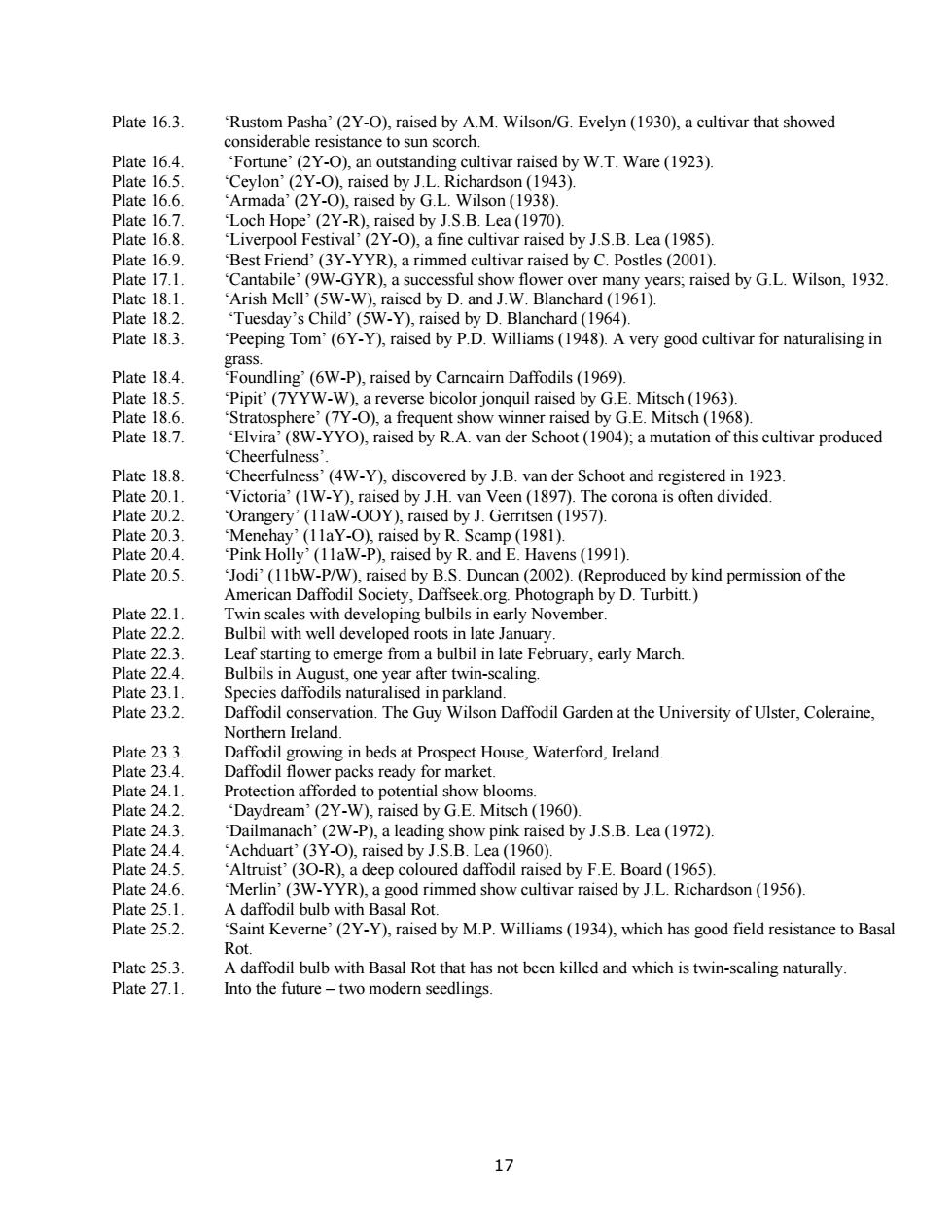
Plate 16.3. Plate 164 e'2Y-0.a ultivar raised by W.T.Ware(1923). Plate 16.5 Cevlon'(2Y-O),ra sed by JL.Richardson (1943). Plate 16.6. 'Armada'(2Y-O),raised by G.L.Wilson(1938). Plate 16.7 'Loch Hope'(2Y-R),raised by J.S.B.Lea(1970). Plate 16.8 'Liverpool Festival'(2Y-O),a fine cultivar raised by J.S.B.Lea(1985). Best Friend(3Y-YYR),a rimmed cultivar raised by C.Postles (2001) wer over ma Plate 18 2 Child (5W-Y D Blan chard (1964) Plate 18.3. Peeping Tom(6Y-Y).raised by P.D.Williams(198).A very good cultivar for naturalising in Plate 18.4. inW-P)raised by ameaiDa( Plate 18.5 'Pipit'(7YYW-W),a reverse bicolor jonquil raised by G.E.Mitsch(1963) "Stratosphere'(Y-O),a frequent show winner raised Plate 18 8 ne(4w.-Y,disc red by ib yan der Schoot and re registered in 1923. Plate 20 'Victoria'(W-Y) ed by J.H.van Veen (1897).The c often divided. Plate 20 2 ry(1aW-OOY).raised by J.Gerritsen (1957) orona Plate 20.3. '(1laY-O),raised by R.Scamp (1981). 1ate20.4 'Pink Holly'(11aW-P),raised by R.and E.Havens(1991). Plate 20.5. Jodi'(11bW-P/W),raised by B.S.Duncan(2002).(Reproduced by kind permission of the American Daff Plat 3 es with early Nover Plate 223. Leaf starting caling ruary,early March Plate 22 4 Bulbils in Plate 23 1 Species daffodils naturalised in parkland. Plate 23.2 Daffodil conservation.The Guy Wilson Daffodil Garden at the University of Ulster,Coleraine Northern Ireland. Plate 23. growing in beds at Prospect House,Waterford.Ireland. ks ready I0 Plat 242 V W) to pote (1960 ach'(2W-P) aised by J.S.B.Lea(1972) Plate 24 4 'Achduart'(3Y-O).raised by J.S B.Lea (1960) Plate 24.5 'Altruist'(30-R),a deep coloured daffodil raised by F.E.Board(1965). Plate 24.6 'Merlin'(3W-YYR),a good rimmed show cultivar raised by J.L.Richardson(1956) Plate 25 A daffodil bulb with Basal Ro Plate 25. aint Keverne'(2Y-Y),raised by M.P.Williams(1934),which has good field resistance to Basal Plate 25 3 tbhBasa Rotthat hspot been killed and hichs Into the fi ture m ng
17 Plate 16.3. ‘Rustom Pasha’ (2Y-O), raised by A.M. Wilson/G. Evelyn (1930), a cultivar that showed considerable resistance to sun scorch. Plate 16.4. ‘Fortune’ (2Y-O), an outstanding cultivar raised by W.T. Ware (1923). Plate 16.5. ‘Ceylon’ (2Y-O), raised by J.L. Richardson (1943). Plate 16.6. ‘Armada’ (2Y-O), raised by G.L. Wilson (1938). Plate 16.7. ‘Loch Hope’ (2Y-R), raised by J.S.B. Lea (1970). Plate 16.8. ‘Liverpool Festival’ (2Y-O), a fine cultivar raised by J.S.B. Lea (1985). Plate 16.9. ‘Best Friend’ (3Y-YYR), a rimmed cultivar raised by C. Postles (2001). Plate 17.1. ‘Cantabile’ (9W-GYR), a successful show flower over many years; raised by G.L. Wilson, 1932. Plate 18.1. ‘Arish Mell’ (5W-W), raised by D. and J.W. Blanchard (1961). Plate 18.2. ‘Tuesday’s Child’ (5W-Y), raised by D. Blanchard (1964). Plate 18.3. ‘Peeping Tom’ (6Y-Y), raised by P.D. Williams (1948). A very good cultivar for naturalising in grass. Plate 18.4. ‘Foundling’ (6W-P), raised by Carncairn Daffodils (1969). Plate 18.5. ‘Pipit’ (7YYW-W), a reverse bicolor jonquil raised by G.E. Mitsch (1963). Plate 18.6. ‘Stratosphere’ (7Y-O), a frequent show winner raised by G.E. Mitsch (1968). Plate 18.7. ‘Elvira’ (8W-YYO), raised by R.A. van der Schoot (1904); a mutation of this cultivar produced ‘Cheerfulness’. Plate 18.8. ‘Cheerfulness’ (4W-Y), discovered by J.B. van der Schoot and registered in 1923. Plate 20.1. ‘Victoria’ (1W-Y), raised by J.H. van Veen (1897). The corona is often divided. Plate 20.2. ‘Orangery’ (11aW-OOY), raised by J. Gerritsen (1957). Plate 20.3. ‘Menehay’ (11aY-O), raised by R. Scamp (1981). Plate 20.4. ‘Pink Holly’ (11aW-P), raised by R. and E. Havens (1991). Plate 20.5. ‘Jodi’ (11bW-P/W), raised by B.S. Duncan (2002). (Reproduced by kind permission of the American Daffodil Society, Daffseek.org. Photograph by D. Turbitt.) Plate 22.1. Twin scales with developing bulbils in early November. Plate 22.2. Bulbil with well developed roots in late January. Plate 22.3. Leaf starting to emerge from a bulbil in late February, early March. Plate 22.4. Bulbils in August, one year after twin-scaling. Plate 23.1. Species daffodils naturalised in parkland. Plate 23.2. Daffodil conservation. The Guy Wilson Daffodil Garden at the University of Ulster, Coleraine, Northern Ireland. Plate 23.3. Daffodil growing in beds at Prospect House, Waterford, Ireland. Plate 23.4. Daffodil flower packs ready for market. Plate 24.1. Protection afforded to potential show blooms. Plate 24.2. ‘Daydream’ (2Y-W), raised by G.E. Mitsch (1960). Plate 24.3. ‘Dailmanach’ (2W-P), a leading show pink raised by J.S.B. Lea (1972). Plate 24.4. ‘Achduart’ (3Y-O), raised by J.S.B. Lea (1960). Plate 24.5. ‘Altruist’ (3O-R), a deep coloured daffodil raised by F.E. Board (1965). Plate 24.6. ‘Merlin’ (3W-YYR), a good rimmed show cultivar raised by J.L. Richardson (1956). Plate 25.1. A daffodil bulb with Basal Rot. Plate 25.2. ‘Saint Keverne’ (2Y-Y), raised by M.P. Williams (1934), which has good field resistance to Basal Rot. Plate 25.3. A daffodil bulb with Basal Rot that has not been killed and which is twin-scaling naturally. Plate 27.1. Into the future – two modern seedlings
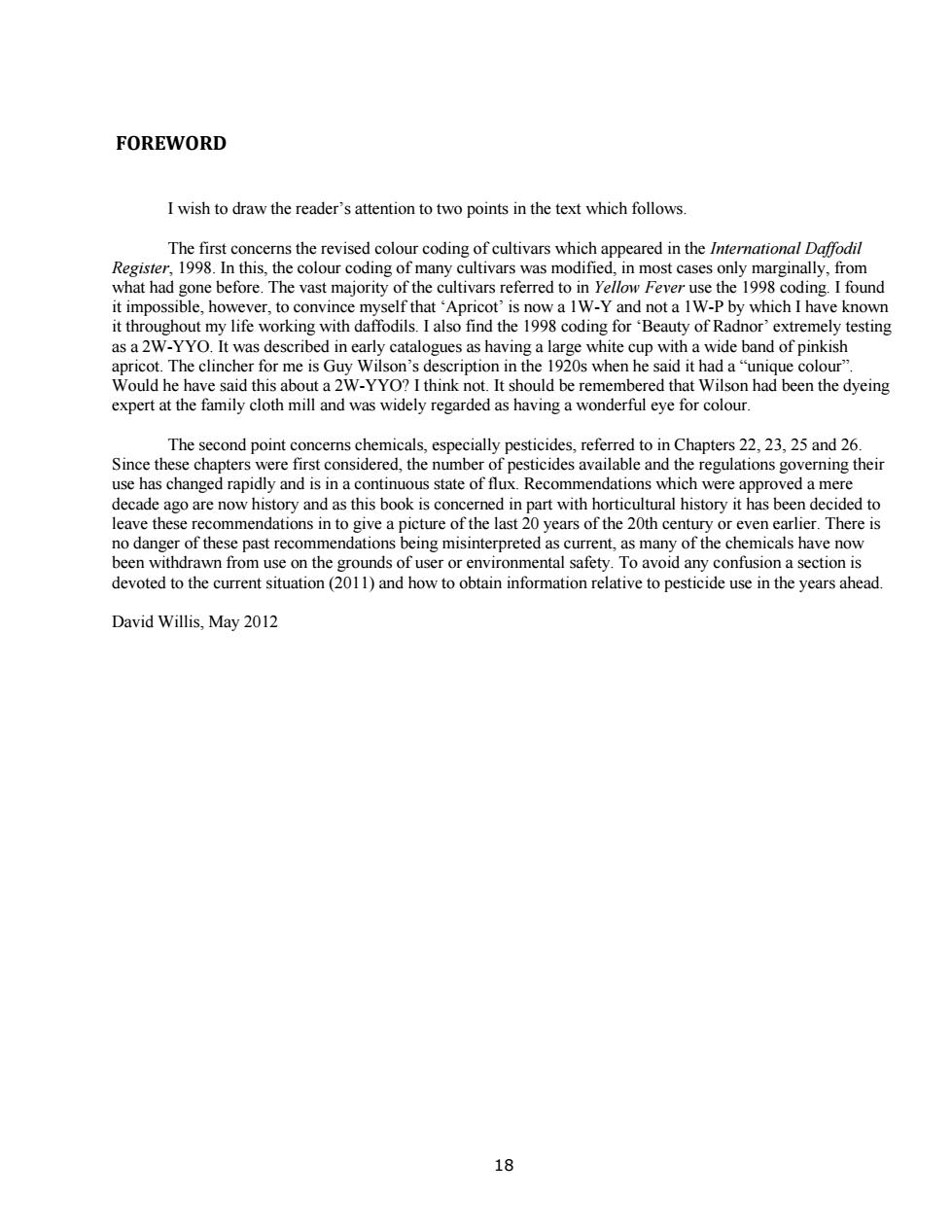
FOREWORD I wish to draw the reader's attention to two points in the text which follows. The first concerns the revised colour coding of cultivars which appeared in the International Daffodil cultivars was modifie in most cases y lif 1998 oding for of Rady which as a 2W-YYO.It was described in early catalog s as having a la e white cup with a wide band of pinkish apricot.The clincher for me is Guy Wilson's description in the 1920s when he said it had a"unique colour' Would he have said this about a 2W-YYO?I think not.It should be remembered that Wilson had been the dyeing expert at the family cloth mill and was widely regarded as having a wonderful eve for colour The second point c ncerns chemi cals,espe ially pestici d,t ava nd as this hook is c ed in t with horticultural histo it has h en decided to ornore c leave these recommendations in to g been withdrawn from use on the grounds of user or environmental safety.To avoid any confusion a section is devoted to the current situation(2011)and how to obtain information relative to pesticide use in the vears ahead David Willis,May 2012 18
18 FOREWORD I wish to draw the reader’s attention to two points in the text which follows. The first concerns the revised colour coding of cultivars which appeared in the International Daffodil Register, 1998. In this, the colour coding of many cultivars was modified, in most cases only marginally, from what had gone before. The vast majority of the cultivars referred to in Yellow Fever use the 1998 coding. I found it impossible, however, to convince myself that ‘Apricot’ is now a 1W-Y and not a 1W-P by which I have known it throughout my life working with daffodils. I also find the 1998 coding for ‘Beauty of Radnor’ extremely testing as a 2W-YYO. It was described in early catalogues as having a large white cup with a wide band of pinkish apricot. The clincher for me is Guy Wilson’s description in the 1920s when he said it had a “unique colour”. Would he have said this about a 2W-YYO? I think not. It should be remembered that Wilson had been the dyeing expert at the family cloth mill and was widely regarded as having a wonderful eye for colour. The second point concerns chemicals, especially pesticides, referred to in Chapters 22, 23, 25 and 26. Since these chapters were first considered, the number of pesticides available and the regulations governing their use has changed rapidly and is in a continuous state of flux. Recommendations which were approved a mere decade ago are now history and as this book is concerned in part with horticultural history it has been decided to leave these recommendations in to give a picture of the last 20 years of the 20th century or even earlier. There is no danger of these past recommendations being misinterpreted as current, as many of the chemicals have now been withdrawn from use on the grounds of user or environmental safety. To avoid any confusion a section is devoted to the current situation (2011) and how to obtain information relative to pesticide use in the years ahead. David Willis, May 2012